Times change, but Howard School has found itself in the same place it was nearly 20 years ago, as problems with the storied South Market Street building seemingly climb by the day.
Today, it's lack of locker space, too few seats in the cafeteria and a dearth of classrooms. Twenty years ago in January, it was the need for new plumbing, heating and electrical systems, a new gymnasium and kitchen, a new roof, and upgrades to the chemistry labs and media center.
Renovations for Howard that would run in the neighborhood of $17 million were on track for a vote by the Hamilton County Commission in the first month of 2003, but Commissioner Curtis Adams had an out-of-the-box thought.
"Why don't we build a new school?" the East Ridge commissioner asked.
It was not part of the Hamilton County Board of Education's facilities plan for new schools, and it might have meant a couple of other schools would have to wait on renovations.
Officials said a new school would cost $20-$22 million, a new site would have to be found, and it would not solve any of the problems at the old school while the new one was being built.
However, Adams said, "I can't see spending that kind of [renovation] money when for a few million more, we could build a new school."
The boomlet of an idea gathered some commission and school board support, enough so that supporters of the then-nearly all Black school rallied in favor of the renovations and traditions of the old building.
"There are a lot of amenities and historically significant assets at Howard that cannot be replaced," said school board member Debra Matthews, who represented the district encompassing the school at the time.
More than 100 renovation supporters subsequently flooded a County Commission meeting, where Adams suggested a vote on the renovations be delayed two weeks so commissioners could tour the school.
"I thought everybody here would be tickled to death with a new school," Adams said. "I thought I was talking in favor of Howard High School when I was talking about building a new school."
Officials said it would be difficult but not impossible to find about 40 acres in the same vicinity as Howard, and a new school would take at least two-and-a-half years to build as opposed to 18 to 24 months for the renovations.
On the day of the vote, some 150 to 200 Howard students marched from the school to the Hamilton County Courthouse for the meeting, urging the renovations. The renovations won out in a 5-3 vote.
Admitting he was "outnumbered and outgunned" by the students and a number of prominent Howard graduates in attendance, Adams presciently said, "If we had gone with a new school, I think in years from now, the student body at Howard High School would be thanking me."
Flash forward 20 years.
Current Howard students and parents want to see better conditions at the school with 1,600 students (the county's largest), but no largely Black contingent of alumni has risen to rally around the school like it did 20 years ago. One reason is that 57.1% of the students, as of numbers early in this school year, are Hispanic. Blacks make up about 40.3% of the student body.
Twenty years ago, and even 10 years ago, no one foresaw the swarm of immigrants who would cross the Southern border illegally and -- as political pawns -- have little worry about being sent home. And if anyone had foreseen the number settling in Chattanooga, they could not have known what schools they would attend.
As it happened, many of the immigrants who settled here found homes in the East Lake and Rossville areas and were thus zoned for Howard School, which at the start of the influx was well under its 854-student capacity.
In the 2012-2013 school year, for example, Howard had 640 students, 88.8% Black, 5.5% white and 5.3% Hispanic. Just four years later, in 2016-2017, the school had 853 students, 57.9% Black, 36.8% Hispanic and 4.6% white.
Hindsight being what it is, it would have been the smarter and more forward thinking decision in 2003 to build a new school when the difference between the cost of renovations and the cost of a new school was relatively little. And had there been a need to add on to a new school, it would have been much easier to do so than retro-fitting an addition to the current building.
Indeed, that's not even being discussed. What is being talked about are using spare classrooms at the adjacent Howard Connect building, considering morning and afternoon schedules, and finding some satellite locations for classes.
District administration, County Commission and school board officials say there is no easy short-term solution to the overcrowded school, but they all must coalesce and exhibit better long-term vision for Howard than did those who -- understandably not seeing the influx of immigrants -- let tradition and nostalgia rule the day in 2003.
